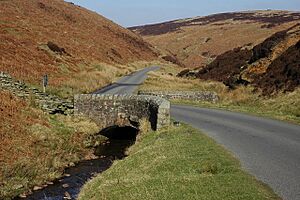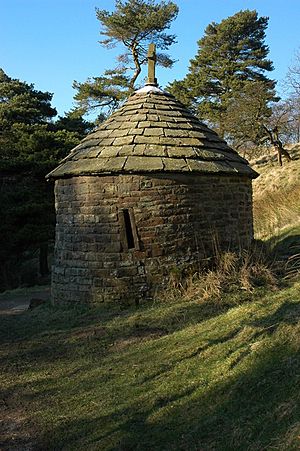Upper Goyt Valley facts for kids
Quick facts for kids Upper Goyt Valley |
|
|---|---|

Fernilee Reservoir in the Goyt Valley
|
|
| Geography | |
| Location | Derbyshire and Cheshire, England |
| Rivers | River Goyt |
The Upper Goyt Valley is a beautiful area in North West England. It is the southern part of the valley where the River Goyt flows. This valley is a popular spot for nature lovers and hikers.
Contents
Where is the Upper Goyt Valley?
The River Goyt starts high up on Axe Edge Moor. This is a moorland area south of the valley. On the west side, a long ridge stretches from Shining Tor to Windgather Rocks. This ridge marks the border between Derbyshire and Cheshire. The river itself used to be the border. To the east, the valley rises towards Burbage Edge. This edge overlooks the town of Buxton and Combs Moss.
The old stone structure called Derbyshire Bridge is important. It gets its name because it was once the historic border. Here, you would cross from Cheshire into Derbyshire. The road heading south from the Goyt Valley is one-way. It crosses over this very old bridge.
A Look Back in Time: History of the Valley
The Upper Goyt Valley has a rich history. Many interesting things have happened here over the years.
Ancient Roads and Old Railways
An old Roman road called The Street runs through the valley. It goes alongside Errwood Reservoir. It also passes to the west of Fernilee Reservoir. This road shows that people have used this valley for a very long time.
A disused railway line also runs along the east side of the reservoirs. This was part of the Cromford and High Peak Railway. It connected the High Peak canal at Whaley Bridge with the River Derwent in Cromford. This railway opened in 1831. However, this part of the line closed in 1896.
Old Mills and Grand Houses
A gunpowder mill used to operate in the valley. It was called the Fernilee gunpowder mill. It started around 1800 near where Fernilee Reservoir is now. A company bought it in 1888 and made it bigger. But it closed in 1920 after several serious incidents.
Errwood Hall was a large mansion built around 1840. It belonged to the Grimshawe family during the Victorian era. Today, it is in ruins. Below Foxlow Edge, there is a special Spanish shrine. It was built in 1889 to remember Miss Dolores. She was a friend of the Grimshawe family. This shrine is now a protected historic building.
The Legend of Pym Chair
There's a local story about a place called Pym Chair. One legend says it's where a highwayman named Pym robbed travelers. He would wait for people on the old packhorse route. Another story says Pym was a preacher. He would give sermons to people right there at Pym Chair.
Reservoirs: Water for Towns
Today, the valley floor is mostly covered by two large reservoirs. These reservoirs hold drinking water. The River Goyt feeds them.
Both reservoirs were built by the Stockport Corporation Waterworks. They bought the Grimshawe family's land to do this. Their goal was to provide drinking water for Stockport town and nearby areas. Fernilee Reservoir was finished in 1938. To keep the water clean, the small village of Goyt's Bridge and Errwood Hall were removed. Errwood Reservoir was completed later, in 1967.
A fantastic suspension bridge once crossed the river. But it was taken down to make way for Errwood Reservoir. Luckily, an old packhorse bridge was saved. It was rebuilt near Goytsclough Quarry. Today, United Utilities owns the reservoirs and much of the land around them.
Moorland: A Special Place for Wildlife
The open moorlands of the Upper Goyt Valley are very important. These areas include Wild Moor, Goyt's Moss, Burbage Edge, and the Shining Tor to Cats Tor ridge. They are called a Site of Special Scientific Interest (SSSI). This means they are protected because of their unique nature.
Plants of the Moorland
The main plant you'll see here is heather. But the moorland is also home to many other plants. These include different grasses, rushes, and shrubs. You can find bilberry, crowberry, cowberry, and cross-leaved heath. Along the Shining Tor ridge, you'll often see hare’s-tail cottongrass and sphagnum moss.
Animals of the Moorland
This area is very important for birds that breed in the uplands. There are many golden plover here. You might also spot red grouse, curlew, lapwing, and whinchat. Other birds include snipe, twite, ring ouzel, and the small merlin falcon.
Along Goyt’s Clough, by the River Goyt, you can see common sandpiper and dipper. The old woodlands in this area have trees like oak, birch, rowan, and alder.
Visiting the Valley
The Upper Goyt Valley has been a popular place for visitors since the 1800s.
Errwood Sailing Club uses Errwood Reservoir for sailing.
The Peak District Boundary Walk is a long walking trail. It comes into the valley from Buxton along the old railway line. It then crosses the Errwood Dam. After that, it follows the west side of the Fernilee reservoir.
There are two large car parks in the middle of the valley. You can find them at The Street and Errwood Hall. Smaller car parks are at Derbyshire Bridge to the south. Another is at the northern end of Fernilee Reservoir. The valley also has many footpaths for walking and exploring.



